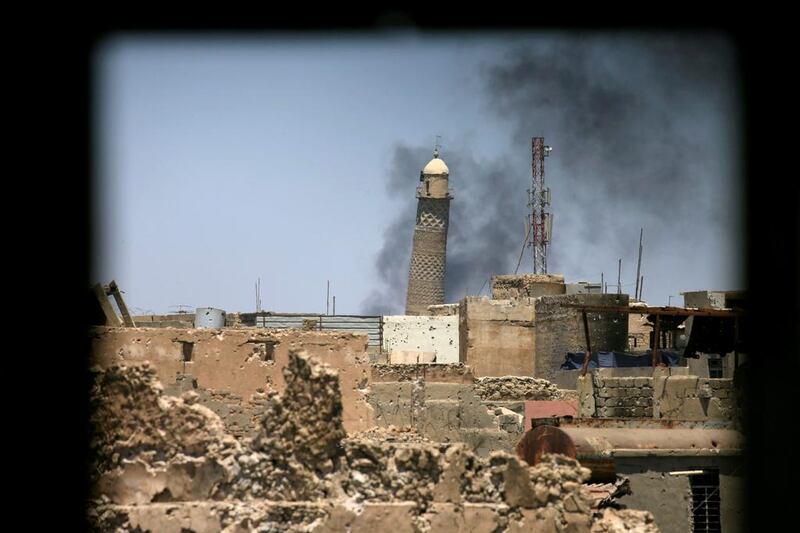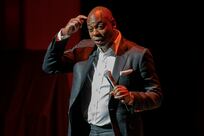ERBIL // To the soldiers taking on ISIL in Mosul, the leaning minaret of the Grand Al Nuri mosque was a yardstick of their progress as they slowly fought their way towards the city centre.
To Moslawis trying to stay alive in the raging battle, the 800-year-old mosque was a reminder of better times that anchored their identity and memories.
But to the terror group, the mosque was the epicentre of its self-declared caliphate, a symbol of its bloodthirsty campaign of conquest.
On Wednesday, Iraqi special forces – who began their campaign to oust ISIL from their last stronghold in Mosul eight months ago – had fought their way to within metres of the mosque and its famous Al Hadba minaret.
Unwilling to let this high water mark of its success fall to the Iraqis, the extremists after nightfall ignited the explosives they had packed into the complex.
The blast reverberated through the narrow streets of the old town, over the desolate neighbourhoods surrounding the centre and across the Tigris river to the bustling east of the city, which had been liberated in January. The news shook Iraq, and quickly made its way around the world.
On July 4, 2014, days after ISIL shocked the world by storming Mosul – Iraq’s second largest city – the group’s leader Abu Bakr Al Baghdadi spoke from the Al Nuri mosque to proclaim himself the caliph, a title last held by the sultans of the moribund Ottoman empire.
Three years on, ISIL is now facing certain defeat in Mosul, and its vast territorial gains have been reduced to small pockets in Iraq’s hinterland and the city’s historic core, where the mosque stood.
The Al Nuri mosque was built in the 12th century by Nur Al Din Mahmoud Zangi, a Turkish Atabeg – a nobleman and provincial governor – who unified Arab forces against crusaders from Europe. It was destroyed by a group of terrorists who also claimed to be fighting western crusaders, but who have unleashed death, destruction and the eradication of cultural heritage in Iraq and Syria.
The demolition of the mosque was the final blow to Mosul’s identity. The leaning minaret, known to locals as “the hunchback”, had been the city’s most famous landmark, and the last to survive ISIL’s assault on its history.
The extremists had destroyed Nebi Younis, the Tomb of Jonah, early on in their reign of terror. They also looted and destroyed the artifacts exhibited in Mosul Museum, a reminder of the city’s proud Assyrian past. The archaeological site of Nimrud near Mosul, once the capital of an Assyrian empire was also looted and blown up.
According to the terror group’s Salafist ideology, the worship of idols is forbidden, and historical objects hold little value to the militants even if they are of Islamic origin. Aware of ISIL’s destructive mindset, Moslawis followed the fighting in their city with a sense of foreboding.
“We feel very sad about the destruction of the mosque. But we expected it to happen in the final phase of the battle,” says Professor Obay Al Dewachi, the head of Mosul University.
Prof Dewachi was confronted with ISIL’s hatred of anything outside their narrow belief system when the extremists in 2015 burned thousands of books and valuable manuscripts kept at the university library.
Of all the destruction wrought by the terror group, the demolition of Al Nuri weighs the heaviest on Mosul’s inhabitants.
“We have lost 90 per cent of our historical heritage during the last three years. But the loss of the mosque is a real disaster for Moslawis” says Prof Dewachi.
While Mosul became increasingly polarised between Sunni fundamentalism and the city’s more cosmopolitan outlook in the years following the second Gulf war in 2003, Moslawis were united in their affection for the mosque and its hunchback minaret, which had been leaning over the old town for as long as they could remember.
“It meant many different things to different people. Mostly, it was a piece of history that was always there,” said Rasha Al Aqeedi, a Mosul native who now works in Dubai as a fellow at Al Mesbar Studies and Research Centre.
The destruction of the mosque will do nothing to delay the final defeat of ISIL in Mosul. Once the jihadists have been flushed out, the people of Mosul face the monumental task of rebuilding their city.
In west Mosul, where the fighting was accompanied by intense bombardment from the air and by artillery, whole neighbourhoods have been razed to the ground. Eventually, the west bank of the Tigris will resemble the east, where the signs of war are already barely visible, and where people go about their daily lives as if the three years of ISIL rule had never existed.
But the loss of its most cherished monument is a legacy of the terror group that the city will never be able to undo.
foreign.desk@thenational.ae





